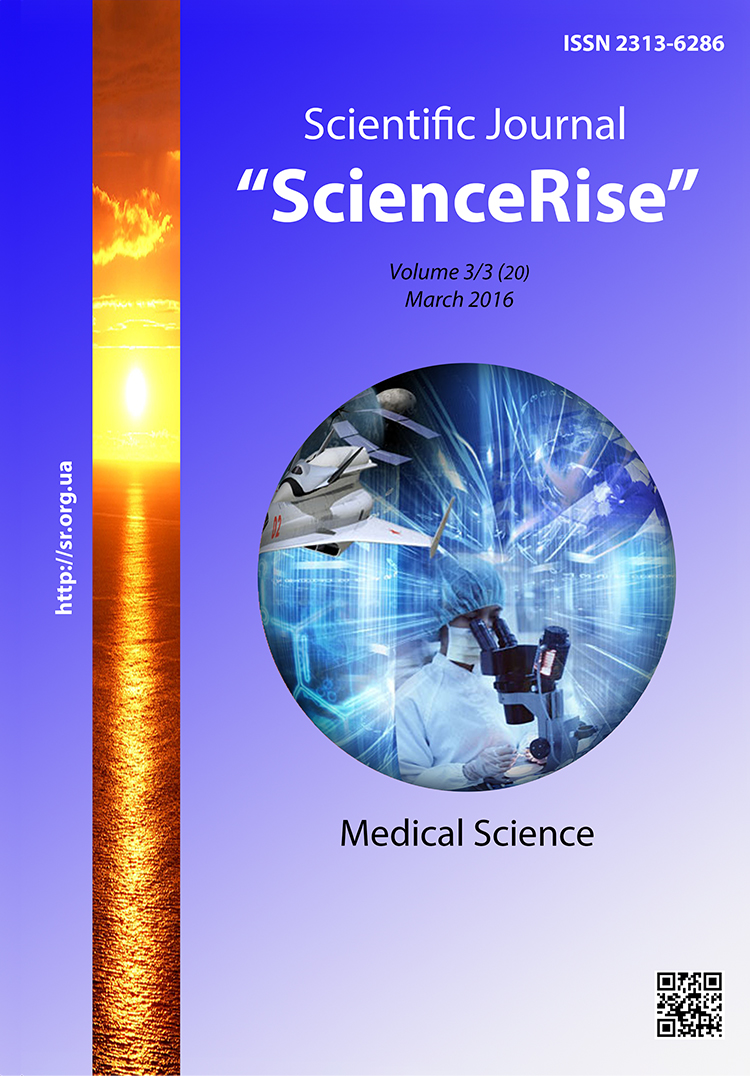Epidemiological features of the skin cancer
DOI:
https://doi.org/10.15587/2313-8416.2016.64835Keywords:
melanoma, carcinoma skin, Kaposi's sarcoma, morbidity, prevalence, recurrence, mortalityAbstract
Background: The relevance of the study of oncological pathology of the skin is due to the annual increase of morbidity rate of skin cancer and significantly high mortality rate among patients. The research of epidemiological features of skin cancer will identify risk groups and those who need primary medical care.
The basis for the research of the epidemiological features of skin cancer among the contingent of SIS – State Institution of Science “Research and Practical Centre of Preventive and Clinical Medicine” of the State Administrative Department (SIS “RPC PCM” SAD) is personalized information on patients that's stored in the database of the SIS since 1996. For the retrospective epidemiological analysis were used data from 2005 to 2014. The obtained results were compared with corresponding figures among patients from Kyiv and Ukraine.
Results: The morbidity rate of melanoma and NMCS (Non-melanoma cancers of the skin) is higher than the corresponding figures of the population of Kyiv and Ukraine, despite the decline in the incidence of melanoma in 2014 by 14 % compared to the year 2013. The mortality rate of patients with skin cancer, mainly due to patients with melanoma, among the contingent of SIS is also higher than the corresponding figures of the population of Kyiv and Ukraine. The majority of patients with skin cancer were men of the 2nd period of middle age and elderly age. The highest morbidity rate of skin cancer was registered in age groups of 65–74 years old and 75 years old and older regardless of gender. The recurrence and prolongation of oncological process were registered among patients with melanoma in 2.3 %, and among patients with NMCS– 1.1 % annually.
Conclusions: The obtained results showed a significant prevalence of skin cancer among the contingent of SIS compared with the morbidity rate of melanoma among the population of Kyiv and Ukraine. The analysis of epidemiological characteristics show the need for raising awareness of primary care physicians of the earliest clinical manifestations of skin cancer, raising patients awareness of the negative effects of ultraviolet radiation and solariums, the need for protection against ultraviolet irradiation, the use of methods of self-examination, timely reference to a doctor
References
Thomas, J. G. (2001). Screening for cancer: evaluating the evidence. Am. Fam. Physician., 63 (3), 513–523.
Lamotkin, I. A. (2006). Tumors and tumor-like lesions of the skin. Atlas. Moscow: Binom. Laboratory Knowledge, 166.
The Surgeon General's call to action to prevent skin cancer. US Department of Health and Human Services (2014). Washington DC: US Department of Health and Human Services, 112. Available at: http://www.surgeongeneral.gov/library/calls/prevent-skin-cancer/call-to-action-prevent-skin-cancer.pdf
Rigel, D. S., Robinson, J. K., Ross, M. I., Friedman, R. (Eds.) (2011). Cancer of the Skin. Saunders, 720.
US Cancer Statistics Working Group. United States cancer statistics: 1999–2012 incidence and mortality web-based report (2015). Atlanta, GA: US Department of Health and Human Services, CDC and National Institutes of Health, National Cancer Institute. Available at: https://nccd.cdc.gov/uscs
Fedorenko, Z. P., Gulak, L. O., Mikhailovich, Yu. Y. et. al (2014). Rak v Ukrai'ni 2012–2013. Bulletin of National Cancer Registry of Ukraine № 15. Kyiv. Available at: http://www.ncru.inf.ua/publications/BULL_15/index.htm
Leiter, U., Garbe, C. (2008). Epidemiology of melanoma and non-melanoma skin cancer – the role of sunlight. Advances in Experimental Medicine and Biology, 624, 89–103. doi: 10.1007/978-0-387-77574-6_8
Genomic Classification of Cutaneous Melanoma (2015). Cell, 161 (7), 1681–1696. doi: 10.1016/j.cell.2015.05.044
Jemal, A., Saraiya, M., Patel, P., Cherala, S. S., Barnholtz-Sloan, J., Kim, J. et. al (2011). Recent trends in cutaneous melanoma incidence and death rates in the United States, 1992–2006. Journal of the American Academy of Dermatology, 65 (5), S17.e1–S17.e11. doi: 10.1016/j.jaad.2011.04.032
Watson, M., Thomas, C. C., Massetti, G. M., McKenna, S., Gershenwald, J. E., Laird, S. (2015). CDC Grand Rounds: Prevention and Control of Skin Cancer. MMWR. Morbidity and Mortality Weekly Report, 64 (47), 1312–1314. doi: 10.15585/mmwr.mm6447a2
Kotenko, K. (2011). Malignant tumors of the skin in Ukraine. Zdorov’ia Ukrainy, 3, 28–29.
Vorobiov, A., Protasova, A. (2010). General screening questions. Practical Oncology, 11 (2), 53–59.
Aitken, J. F., Youl, P. H., Janda, M., Lowe, J. B, Ring, I. T., Elwood, M. (2005). Increase in skin cancer screening during a community-based randomized intervention trial. International Journal of Cancer, 118 (4), 1010–1016. doi: 10.1002/ijc.21455
Downloads
Published
Issue
Section
License
Copyright (c) 2016 Оlena Oshyvalova

This work is licensed under a Creative Commons Attribution 4.0 International License.
Our journal abides by the Creative Commons CC BY copyright rights and permissions for open access journals.
Authors, who are published in this journal, agree to the following conditions:
1. The authors reserve the right to authorship of the work and pass the first publication right of this work to the journal under the terms of a Creative Commons CC BY, which allows others to freely distribute the published research with the obligatory reference to the authors of the original work and the first publication of the work in this journal.
2. The authors have the right to conclude separate supplement agreements that relate to non-exclusive work distribution in the form in which it has been published by the journal (for example, to upload the work to the online storage of the journal or publish it as part of a monograph), provided that the reference to the first publication of the work in this journal is included.

